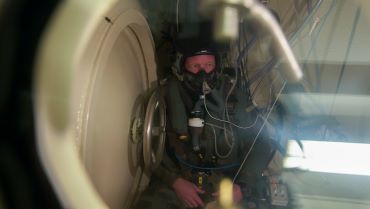 IF FOR some reason the cabin pressure would suddenly fall when a combat pilot is at high altitude, it can have fatal consequences. In Gripen there are systems that quickly detect if it should happen and also take the necessary steps to protect the pilot. As part of the testing of Gripen E, a number of tests were recently conducted to verify these systems.
IF FOR some reason the cabin pressure would suddenly fall when a combat pilot is at high altitude, it can have fatal consequences. In Gripen there are systems that quickly detect if it should happen and also take the necessary steps to protect the pilot. As part of the testing of Gripen E, a number of tests were recently conducted to verify these systems.
From the second Gripen E aircraft (designated 39-9) and onwards, Gripen E have several new systems installed, including an On-Board Oxygen Generating System (OBOGS) and anti-g system.
The system works according to set requirements
The purpose of the recent tests at Karolinska Institutet in Stockholm was primarily to verify that these systems work according to the requirements set and that they are compatible with the aircrew equipment assembly, that the pilots will use in the future. The test also gave an increased confidence that the system is ready for flight and also enabled the pilots to know how the system works before it is mounted on the aircraft.
– The focus was to verify that the system gave the correct pressure to the oxygen mask and G-suit depending on the actual altitude. In addition, it was checked that the oxygen level that the system generates to the pilot is in line with what is required, “says John Färnstrand, flight test engineer, Saab Aeronautics.
Conducted in a pressure chamber
In short, the tests were carried out in two different pressure chambers, where one chamber simulated the cabin in the air craft and the other simulated a non-pressurized space (device space), where OBOGS was mounted. Initially a test doll together with a respiratory simulator was used in the tests. After that, a test pilot stepped in to do corresponding tests and to evaluate the functioning of the systems.
Simulation of lost cabin pressure
The samples also included a so-called explosive decompression, simulating the sudden drop in cabin pressure at high altitudes. In reality, this could, for example, be due to the explosion or loss of the aircraft hood. If this happens the system will quickly detect it and also take the necessary steps to protect the pilot.
– In order to achieve a so-called explosive decompression we mounted a large specially designed hatch between the two chambers that enabled a rapid equalization of the pressure. However, this test was only done with a test doll due to the risks, says John Färnstrand.
Several businesses participated
From Saab, there were personnel from several different departments involved during the tests, such as system engineers, test pilots, technicians and test engineers. This type of test also requires medical supervision, so a flight physician attended and was responsible for safety and monitored the test pilot’s health throughout the tests. There were also KTH researchers who supported in various ways.
This type of testing has been carried out earlier, for example with the previous oxygen and anti-g system, but also when introducing new pilot equipment with CBRN protection.








